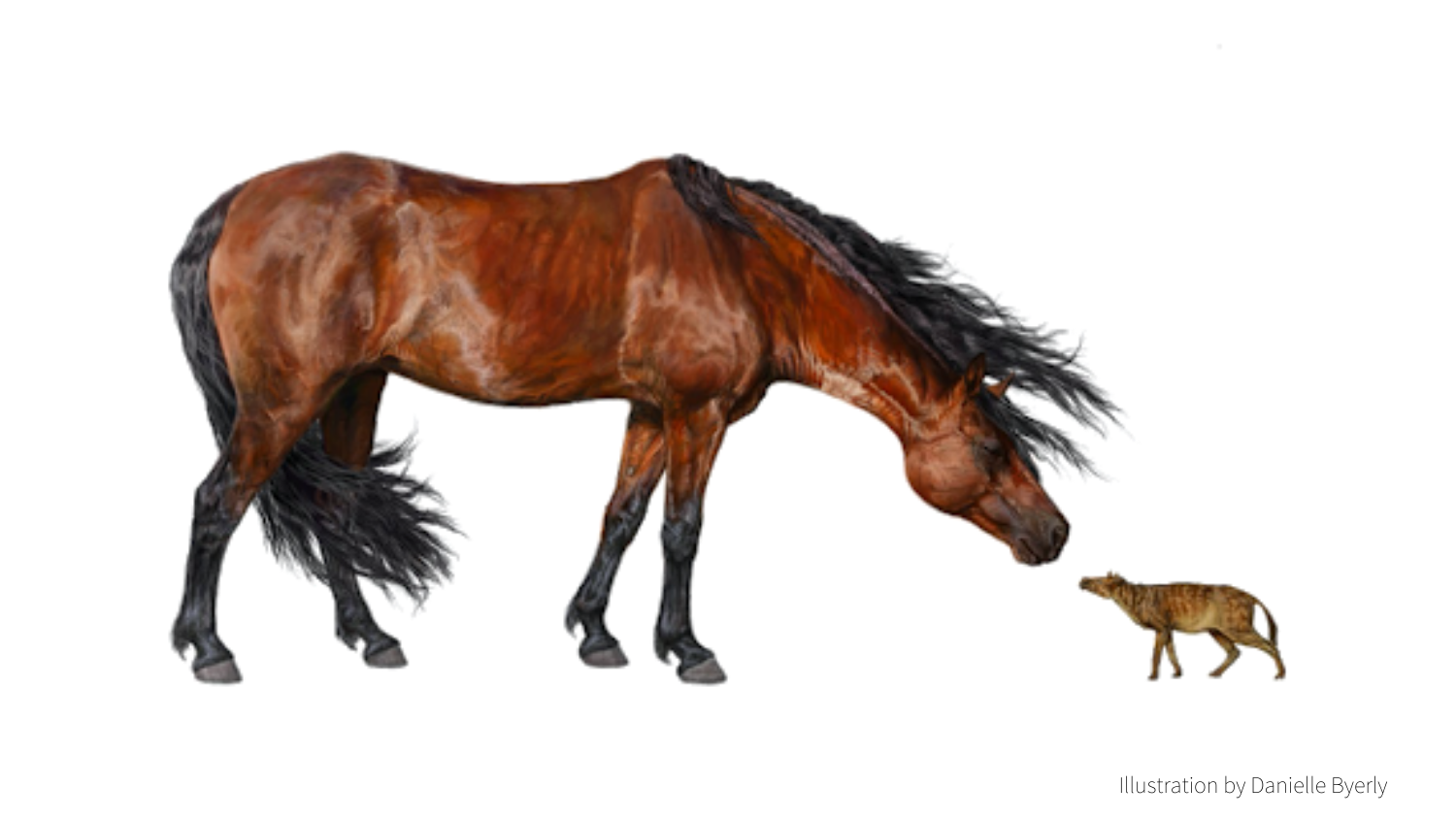
This is a guest post by Rob Dunn and friends.
Ethan Coffel (EC) is an assistant professor of geography at Syracuse University. He researches how climate change will affect people, and how our adaptation choices will affect our vulnerability to climate extremes in a warmer world (www.ethancoffel.com). Steve Sherwood (SS) is a professor of meteorology and climate dynamics at the University of New South Wales in Sydney, Australia. Abigail D’Ambrosia (AD) is an assistant professor of biology (and more specifically, paleoecology) at Southern Arkansas University. The three sat down (virtually) with Rob Dunn (RRD) to talk about future warming and ancient warming and its consequences. The interview starts with questions for Ethan and Steve about the future and then loops Abigail in to help us consider how the past helps us think about the future.
Note: In the interview, “wet bulb temperature” comes up again and again. Wet bulb temperature is a measure of temperature that combines temperature and humidity. We will get into its significance more in the interview, but the basic idea is simple. The figure below shows how to calculate the wet bulb temperature on a given day if you know both the temperature and the humidity.

RRD: Can you walk me through what happens to the human body at different wet bulb temperatures? At 30? At 32? At 35?
EC: It’s a sliding scale where our ability to lose heat through evaporative cooling declines. As wet bulb temps rise, heat more easily accumulates in the body, core temperature rises, and you experience heat illness.
SS: A wet-bulb of 30C would exceed guidelines for physical activity, making it dangerous. 32C would obviously be worse and probably dangerous even without physical activity, especially for someone not adapted to heat.
EC: If your temperature continues rising, your organs eventually fail. There is possibly a threshold at 35C (95 F): this is about the temperature of our skin, and if wet bulb temperatures exceed 35C, we won’t be able to shed heat through evaporative cooling. This means we have no way to cool ourselves – we would need to get to a cooler place to avoid heat illness.
RRD: What do you think the most immediate consequences of rising wet bulb temperatures are likely to be for human societies?
SS: They are already driving behavioural changes, decreasing work productivity especially in hot climates, and increasing the frequency of incidents where it is too hot for physical activities such as summertime sports tournaments. This will continue and become more obvious, as we are now emerging from the envelope of natural variability and beginning to experience unprecedented conditions in many areas on a more frequent basis.
RRD: How many places have already seen wet bulb temperatures above 35 C (95 F)?
SS: A paper early this year reported a few measurements hitting 35C in a couple of coastal cities in the Persian Gulf region. It is not certain that these observations were accurate, but it does appear that 35C values sometimes occur over the Gulf itself because the ocean has become so warm, so all it takes is for this air to reach a city. The events when it does so are very rare and brief. In most places the wet-bulb temperature never exceeds 30C in today’s climate.
RRD: How many places will have wet bulb temperatures above 35 C by 2050 (or choose a different benchmark if you want)?
EC: This will probably still be rare by 2050. After that it really depends on our emissions – one of my findings is that large scale exposure to wet bulb temperatures above 35C could be greatly reduced if not prevented all together (at least in this century) by keeping global temperatures in the 2C (3.6 F) range.
SS: It depends on global warming, which obviously depends on what we do. The maximum wet bulbs rise by about ¾ of a degree for each one degree of global-mean temperature rise.
RRD: Two degrees of warming is in line with the climate scenario RCP2.6 in which we radically reduce emissions. This scenario assumes emissions begin to decline by 2020, this year. It also requires that emissions are zero by 2100. Correct?
EC: Yes, RCP2.6 comes in right around 2C of warming by 2100 on average. In general scenarios that limit warming to 2C this century require an immediate reversal in emissions trends (to decline instead of rise) and for net greenhouse gas emissions to reach net zero around 2050 or so. However, many of these scenarios also assume that we implement “negative emissions” after 2050, where we pull carbon out of the atmosphere. Technology to do this does not exist at scale yet. A scenario that limits warming to 2C without negative emissions requires even faster emissions reductions.
RRD: Sorry. Continue.
EC: But if warming ends up being 3-4C by 2100, then there could be substantial exposure to 35C.
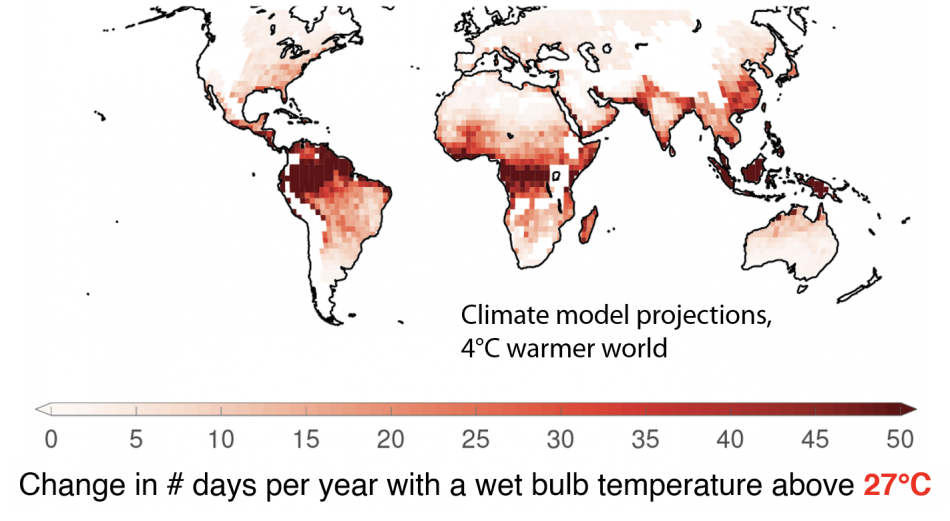
RRD: Steve, in your recent paper in PNAS you describe regions in the future that have the potential to be too hot (wet bulb temperatures) to be occupied by humans. You describe them as small regions with seven degrees (C) of warming, but if I look at figure in your paper that relates to twelve degrees of warming (clipped out below) we are talking about big parts of the United States, Australia and the Amazon, among other regions, much of Earth’s land area. Is that right?
SS: Yes
RRD: How different is that scenario from, say, the hottest part of the Eocene?
SS: Probably not far off.
RRD: Abigail, tell us about the Eocene? What would we encounter in the iconic Eocene forest?
AD: The Eocene epoch lasted from 56 million years ago to around 34 million years ago. It’s a really interesting time in our planet’s history in that there are no major ice sheets. Earth scientists call this a “hothouse” world, and some estimates have the early Eocene global temperatures reaching up to 14˚C higher than today.
RRD: Ethan, are there climate change scenarios in which we get to 14 C hotter than today in the future?
EC: For that to happen we would have to burn all the fossil fuels that we currently know exist (and then some). This doesn’t seem very plausible, if only because climate damages would be so severe that it would probably be hard to maintain an industrial economy. So absent some climate response that we aren’t expecting, warming of this magnitude seems unlikely in the next couple of centuries.
RRD: Sorry, so, what would a forest be like Abigail?
AD: Imagine standing in the Arctic—but instead of being surrounded by snow and ice, you are surrounded by large trees—including palm trees. At your feet, a large crocodile swims by! Now transport yourself to the mid-latitudes.
RRD: By mid-latitudes you mean like a band across North America from New York to California, say?
AD: Exactly. The contiguous US falls within those “mid-latitudes.” Forests across the continental US would have ranged from savannah-like to closed-canopy and very tropical. In these forests you might come across lemur-like primates (our early ancestors!) swinging from tree to tree, tiny deer-like mammals the size of rabbits noshing on the understory vegetation, and the earliest predecessors to horses (which were dog-sized and had toes) bounding between the trees along the forest floor.
RRD: Wait, so they were like half monkey half horse?
AD: Hah! Not quite. These early horses looked more like a small modern African duiker or dik-dik. I mention they are living within the forest because this is so different from modern horses (who live across grasslands). Nearby you might find tusked hippo-like beasts chilling in the local swamps, and among them lots of turtles and crocodilians basking in the very warm sunshine.
RRD: Wow, it it almost, for lack of a better word, whimsical. But at 14 degrees hotter than today, it would have been unbearable for us, yes? Great for monkey-horses, but not for a species with our physiology.
EC: Yes, many of the places where people currently live would be intolerably hot.
RRD: When did peak temperatures occur in the Eocene and how hot were they?
AD: Actually, the moment in time that defines the beginning of the Eocene epoch is the moment in time when temperatures were the hottest (albeit, briefly, geologically-speaking). It’s known as the Paleocene-Eocene Thermal Maximum (PETM). The latest estimates suggest the Earth warmed about 5-9˚C in 10,000 years (or less!). This event is associated with a massive increase of CO2 in Earth’s atmosphere.
RRD: Was this hot and wet, hot and dry or both?
AD: So it turns out, there was a series of these brief, but extreme, warming events that all occurred around the same time.
RRD: OK, so really we should be talking about a series of global warming events in the Eocene, each with its own details.
AD: Yes. In Wyoming, where my field research is based, paleosol records indicate that during the PETM the hydrological cycle shifted to more variable and often dryer climatic conditions (though overall still tropical—as we see tropical plants preserved in the fossil record… in Wyoming!). During a subsequent, slightly less extreme warming event (known as ETM2), paleosols suggest increased soil moisture (and less arid conditions). One thing is for sure, it was pretty darn hot during both events!

RRD: So in a brief window of time, preceding a radically transformed ecological world, carbon dioxide levels rose rapidly, temperatures rose rapidly, and the world became god-forsaken hot and populated with monkeys, tiny horses and rabbit-deers. It reminds me of a Heironymous Bosch painting. And sometimes that world was hot and somewhat dry (but not a desert) and in other cases hot and wet.
RRD: So this is a good reminder that even with much hotter temperatures, life does end, not even for mammals, but it as the world warms life as we know it gets much harder (life as we like, we might also say). Ethan and Steve, to what extent does culture allow the potential to cope with high wet bulb temperatures? By working at night? By building houses differently?Up to what temperature are there still behavioral ways of keeping society running despite the temperatures?
EC: I think this is an important question which I’m not sure that there’s been much research on. What we do know is that social factors are major drivers of heat deaths – in heat waves in Chicago, Europe, and other places disadvantaged groups experienced the majority of the impacts.
SS: These and other adaptations have always been used for heat stress in hot climates. Such adaptations would become more widespread as climate warms. But places that already use these adaptations might be challenged to cope with further rises in heat stress. There are indications that climate-driven human migration has already begun, and I expect it to accelerate rapidly if warming exceeds the 2C Paris target.
RRD: All of this is to say that globally poorer countries have the most direct risk from extreme temperatures and in affluent countries marginalized peoples are often most likely to face the most direct risk?
EC: Right, and it’s also important to note that emissions are highly correlated with income, so it’s the richer countries (and richer people within those countries) that do the activities that produce most of the emissions. So generally the people hurt most by climate change are the least responsible for it.
RRD: Are people in cultures that have had more experience with extreme temperatures (for example, those cultures living in hot deserts) more predisposed to being able to deal with future temperatures?
EC: Definitely there is societal-level adaptation. You can see this just thinking about heat waves – in 2003 there was a heat wave in Europe that killed tens of thousands of people. But the temperatures in this heat wave would not have been remarkable at all in Dubai or even Phoenix. But buildings, access to A/C, and peoples’ behaviour are different, and these can shape vulnerability.
RRD: But as Steve points out, those places may be at their limit to buffer additional heat.
RRD: Is there a way to know which regions will have the most lost work days in the future due to high wet bulb temperatures?
EC: It will depend on the prevalence of outdoor work and access to air conditioning. These often scale with income. Agricultural workers are particularly at risk here.
RRD: So, broadly speaking, the prediction is for the biggest impact in regions that are going to experience a lot of warming and are agricultural and especially poor and agricultural. And, more specifically, the poor people who do the work in those countries.
RRD: What is the highest wet bulb temperature you have experienced?
EC: Probably around 30C (which is equivalent to, for example, 50 degrees C/122 degrees F dry bulb temperature and 20 percent humidity).
SS: I unfortunately don’t remember exactly, but years ago I experienced what I recall was about 27C during a record heat day in Connecticut. I was playing ultimate frisbee and wondering whether any of us should be out there. Today I think the event would be canceled. A good way to get a sense for what a 3C difference makes in terms of wet-bulb temperature, is to find a jacuzzi somewhere and compare how it feels at 36C (97F) vs. 39C (102F). At 36C you’ll get cold after a while; at 39C you’ll have to get out because you’ll be overheating. Obviously when you do this you need to keep your head out of the water! Which you can’t do when it’s the air that has a wet-bulb of 36C.
RRD: Long-term, do you think there are ways for just, equitable societies to persist in the regions that are predicted to have the highest wet-bulb temperature?
EC: I imagine that it’s possible with good governance, national wealth, advance preparation, and a huge switch to renewable energy, but it definitely is a tough problem.
RRD: And for context, the regions we are talking about (the regions that need good governance, preparation and renewable energy) include parts of the eastern United States along the Mississippi River, the Amazon rainforest, Nigeria, Pakistan, India and China.
RRD: Is there an estimate of the capacity of different countries to air condition themselves out of high wet bulb temperatures?
EC: Capacity will be limited by income (to buy the air conditioners) and the ability to produce electricity to run them. A/C is projected to drive an enormous increase in electricity demand, so it’s really crucial that this come from solar/wind rather than fossil fuels. Otherwise keeping ourselves cool will just keep making things hotter.
SS: Australians are installing air conditioning and that trend will sadly continue. Where I live it has always been possible to manage summertime heat without aircon but I fear this will become difficult as time goes on.
RRD: How does this extreme heat affect the biology and behavior of non-human mammals?
AD: One interesting effect to consider is Bergmann’s rule. Very basically, some animals at high latitudes tend to be larger than animals of the same genus/species at lower latitudes. Scientists have hypothesized this may have something to do with surface-area-to-volume ratios: It’s easier to keep warm if you are large (with a low SA:V), and easier to release heat to the environment if you are small (with a high SA:V).
RRD: Right, this was Carl Bergmann’s original hypothesis (hence the name of the rule) in the 1800s. So if an animal is really small or really thin (like a Giacometti dog), it has a lot of skin over which to get rid of its heat (for example, by sweating) and not much volume to get rid of that heat from.
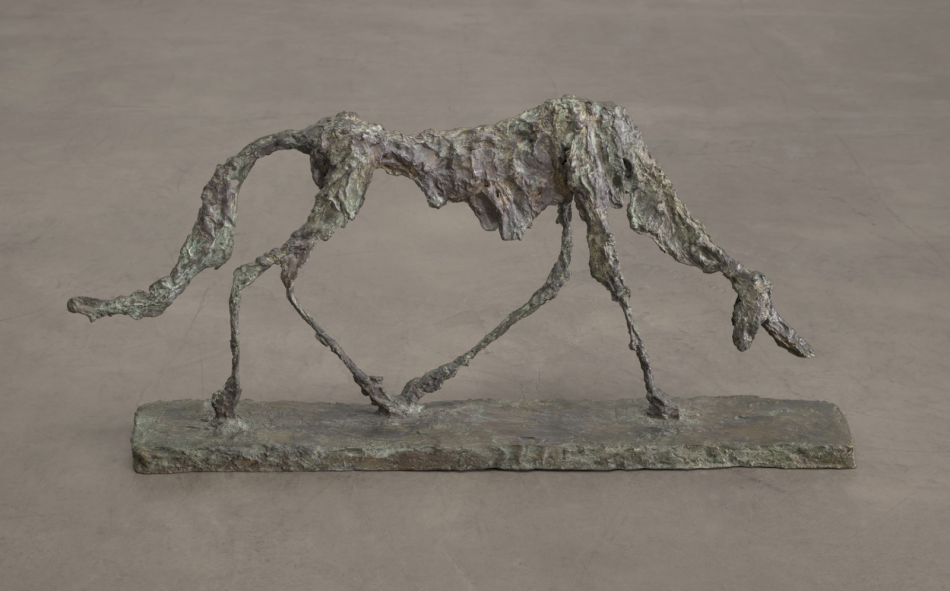
AD: Yup. So theoretically, as temperatures rise across the planet (and across latitudes), you might expect body size in some species to decrease.
RRD: And for animals to get more slender.
AD: But now we have to consider… is body size decrease a true genetic change? …a phenotypic response? …or something completely different, like a shift to the geographic ranges of some species?
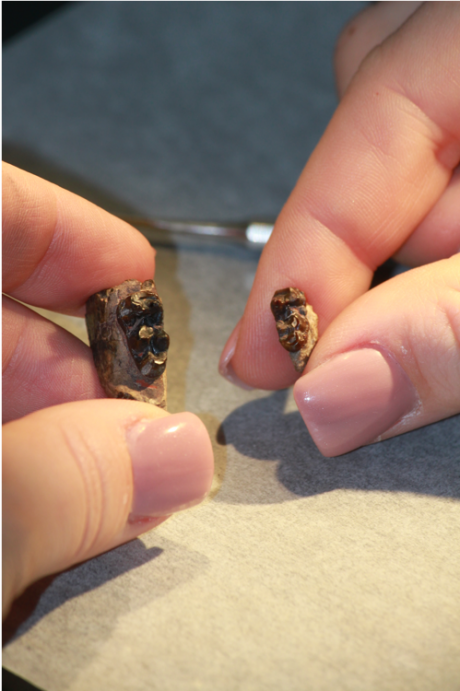
RRD: You mean, is any body we see in the fossil record a true genetic change? I guess to go back to Giacometti’s dog, it could be skinny because it has skinny genes or because Giacometti didn’t feed it well.
AD: For sure! Either way, organisms have to adapt to warming conditions and the associated environmental changes (adapt to a new food source? …a new habitat?), and/or move. One thing we are already seeing in species across the planet today is shifting geographic ranges to higher latitudes as the planet warms.
RRD: Going back to the Eocene, you’ve shown that body size in mammals declined with increases in Eocene temperatures. Which mammals did this occur in? Are there any rules about which mammals decline in body size and which don’t with warming?
AD: The clearest example of this body size decrease is with the early Eocene horses. During both the PETM (the first big warming, when conditions were warm and dry) and ETM2 (the second big warming when conditions were warm and wet), we see clear and significant “shrinkage” in these animals. During the PETM, they decreased in size by about 30%. During ETM2, they decreased in size about 14%.
RRD: Wow. 30%. That is like turning a horse into a pony.
AD: What is fascinating is that these animals rebounded to their “normal” body size when temperatures returned to the normal background levels! We see similar evidence in a couple of other mammals of the time, though it’s not quite as clear. Right now, we are still trying to determine the exact “rules” for who and why. Currently, I am investigating the idea that the Eocene horses followed Bergmann’s rule, and that as the planet warmed, their smaller-bodied counterparts to the south shifted their geographic range northward (replacing the large-bodied horses who may have also shifted their geographic range north).
RRD: So it may have been a mix of big horses becoming rarer, smaller horses extending their ranges and both big and small horses evolving smaller body size.
AD: Yes. With continued field work and fossil collection, hopefully we’ll have some answers soon!
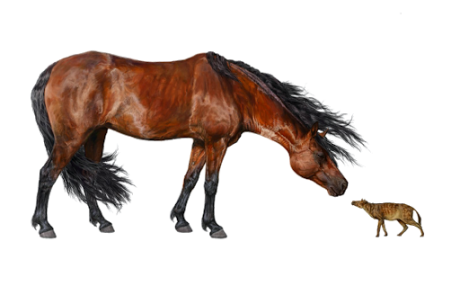
RRD: Is the high risk that humans face due to high wet bulb temperatures partially a unique feature of the evolution of our sweat glands? Do mammals that don’t rely on sweating to keep cool face the same risk?
EC: Any animal that relies on evaporative cooling (panting, sweating) will face the same problem, although their wet bulb temperature tolerance may vary.
RRD: Do you anticipate regions of the Earth, by 2100, that are too hot for humans to go outside in without protective cooling suits?
EC: Probably not as acute as that, but there very well might be places where it’s impossible to work outdoors for substantial parts of the year and where during heat waves air conditioning is required to avoid heat illness and death.
RRD: If current warming trends continue for, say, a thousand years, do you expect similar trends with regard to which species will go extinct to what we saw in the Eocene?
AD: Well, the good news is that during the PETM, there weren’t any major extinctions within the terrestrial realm. To the contrary, with the onset of the PETM, we see the appearance of modern lineages of organisms—the perissodactyls (odd-toed ungulates, like horses), the artiodactyls (even-toed ungulates, like deer and pigs), and the primates (us!).
RRD: Well, by major extinctions you mean we didn’t lose a whole group of animals (such as horses), but the fossil record doesn’t tell us much that far back about the loss of species, no?
AD: There is probably always some level of fossil preservation bias going on, and we do see a few terrestrial species disappear at the beginning of the Eocene– but there are no indications it was to the level of a mass extinction. On the other hand, the marine realm during the PETM did experience a mass extinction (but mostly in benthic microscopic organisms called forams). And, that said, CO2 is rising at 10x the rate today than it did at the PETM. So now the question is whether animals will have time to adapt the way they did 56 million years ago. Yes, I do think we will see decreases in body size in some species. In fact, it’s already been documented (high latitude moose populations, red deer, and the California squirrel come to mind). But now we have to consider the following: generation time (especially if the body size decrease is anagenetic), and/or rates of geographic shift (can they move fast enough to keep up with the shifting temperatures across latitudes?).
RRD: Are big species most at risk within lineages?
AD: Great question! I suspect bigger species with slower generation times at high latitudes might indeed be especially at risk. With slow generation times, they might not adapt to changing temperatures fast enough, and if they are already at the high latitudes, they can’t shift their geographic range any higher. Ultimately, I am afraid that we will see many species go extinct when all is said and done (especially across the Arctic, which is seeing more drastic temperature increases than anywhere else on the planet right now).
RRD: How fast might we expect changes in the body size of, say, felids over the coming thousands of years with warming?
AD: Well, if the changes in body size are a true genetic response to warming (meaning, smaller body size is “favored” via natural selection and is heritable) generation time plays a big role. Can they keep up with the demands imposed on them by their rapidly changing environment? I don’t know much about felid generation times, so I’ll just bring it back to those tiny Eocene horses! During my master’s research, I came across evidence suggesting they were capable of reproducing up to two times per year. So, if the “dwarfing” we are seeing in these Eocene horses is genetic, apparently being able to reproduce 2x per year over 10,000 years was enough to keep up! …But again, we are warming at a much faster rate today.
RRD: Ethan, is there any evidence that deaths during heat wave are non-random with respect to human genetic differences? Are people with genes associated with smaller bodies (or narrower bodies) less likely to die during heat waves?
EC: I don’t know of any evidence of this.
AD: There’s one final point I’d like to make (and kind of re-emphasize): When comparing our current warming planet to the warm Eocene planet, it’s really the rate of atmospheric CO2 increase and warming that is so alarming today. In that sense, we are kind of living through uncharted territory. I’m not sure there was ever a time modern humans (and modern civilization as we know it) have had to navigate such drastic environmental changes on the global scale.
RRD: Why did you begin studying hot days, hot years, and the hot future? Or, in your case Abigail, the hot past?
AD: It was a bit of an accident. After getting a degree in geology as an undergrad, I knew I wanted to work with fossils. So, I found a PhD advisor who I could do this work with: Will Clyde at University of New Hampshire. Turns out that one of his research focuses was studying the fossil record across the PETM in Wyoming. My PhD work kind of picked up right as we were uncovering ETM2. Before I knew it, I was a paleoecologist and paleoclimatologist!
EC: I think it will be one of the most direct and severe impacts of climate change for a huge number of people, even if it’s not the most dramatic.
RRD: I guess if it seems plenty dramatic to me.